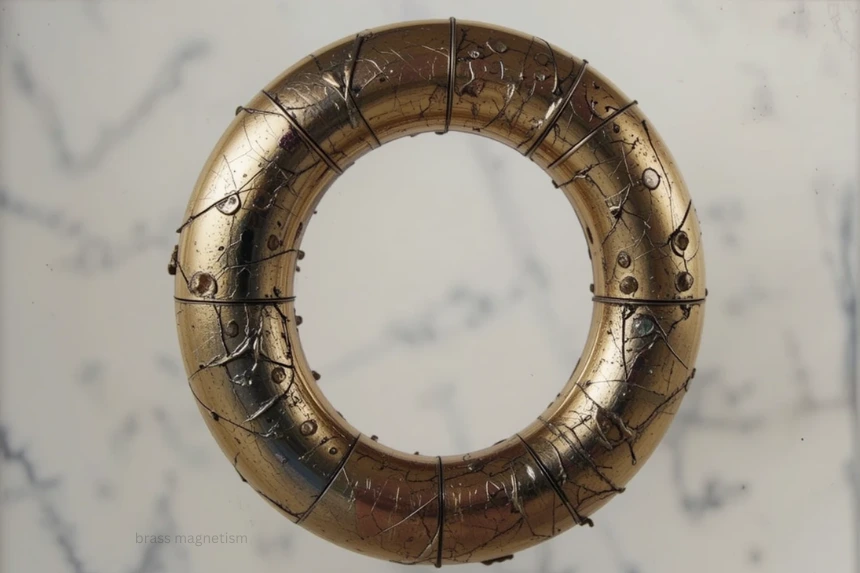Brass magnetism is an intriguing subject that delves into how a common alloy interacts with magnetic fields. Although brass is traditionally considered a non-magnetic material, understanding its magnetic properties—collectively referred to as “brass magnetism”—is essential for various engineering, decorative, and functional applications. This article explores the concept of brass magnetism, clarifies whether brass is magnetic, and discusses its practical implications across different fields.
What Is Brass and Its Composition?
To comprehend brass magnetism, it’s important first to understand what brass is. Copper and zinc make up the majority of the alloy known as brass. Its specific composition varies depending on its intended use, but typically it contains between 55% and 95% copper, with the remaining percentage being zinc. Some brass alloys also include small amounts of other elements such as lead, iron, or aluminum to enhance certain properties.
Because of its composition, brass is widely appreciated for its malleability, corrosion resistance, and attractive golden appearance, making it a popular choice for musical instruments, decorative items, fittings, and jewelry.
Is Brass Magnetic? The Truth About Brass Magnetism
A common question related to brass magnetism is whether brass is magnetic.The simple explanation is that brass is typically thought to be non-magnetic. The main component, copper, is diamagnetic, which means that magnetic fields are slightly repelled by it. Zinc, the other main element, is also diamagnetic, and thus, pure brass does not exhibit magnetic properties under normal circumstances.
However, it’s important to note that not all brass alloys are completely non-magnetic. The magnetic behavior can be affected by the presence of specific elements or contaminants. For instance, some brass alloys contain small amounts of iron or nickel, which are ferromagnetic, and may result in a weak magnetic response.
In particular, free-machining brass alloys that contain added iron or nickel components can exhibit mild magnetic properties. This is often viewed in industrial contexts where different brass compositions lead to varying magnetic responses.
Factors Affecting Brass Magnetism
While pure brass is typically non-magnetic, certain factors can influence its magnetic behavior:
- Alloy composition: Variations in zinc, copper, or added elements like iron or nickel can turn an otherwise non-magnetic brass into a weakly magnetic material.
- Impurities: Contamination or impurities during manufacturing can introduce ferromagnetic elements.
- Mechanical deformation: Strain or deformation may alter the atomic structure temporarily, though it generally does not impart magnetic properties to non-magnetic brass.
- Temperature: Some alloys may exhibit different magnetic behavior at extremely low or high temperatures, but these are specialized cases.
Practical Applications of Brass’s Magnetic Properties
Understanding brass magnetism is significant in several fields. Here are some common applications and considerations:
1. Jewelry and Decorative Items
Most brass jewelry is unaffected by magnetic fields because of its primarily diamagnetic nature. However, if the alloy includes magnetic impurities, it may weakly attract magnets, which is useful to know for certain design or manufacturing purposes.
2. Electrical and Electronic Components
In electrical engineering, brass is often used for connectors, fittings, and terminals because of its excellent conductivity and corrosion resistance. Since non-magnetic brass does not interfere with magnetic fields, it is suitable for applications where magnetic interference must be minimized.
3. Magnetic Shielding and Components
In some specialized cases, alloys with ferromagnetic elements are used to create magnetic shielding or components that interact with magnetic fields. If brass contains magnetic impurities, it can serve these functions modestly, but pure brass usually does not.
4. Industrial and Manufacturing Contexts
Manufacturers need to know if their brass parts are magnetic because magnetic properties can influence sorting, machining, or assembly processes. Brass with iron content, for instance, may be attracted to magnetic tools or machinery, affecting production workflows.
Testing Brass for Magnetism
If you’re uncertain whether a particular brass alloy exhibits magnetic properties, simple testing can help:
- Use a magnet to see if the substance is attracted.
- Use a powerful neodymium magnet to conduct a magnetic pull test
- To find out whether ferromagnetic components are present, consult the alloy requirements.
The Scientific Perspective on Brass Magnetism
From a scientific standpoint, the term “brass magnetism” involves understanding how the electronic structure of the alloy’s elements responds to magnetic fields. Typically, the interaction is weak due to its diamagnetic nature, meaning brass opposes any magnetic influence very slightly.
However, the presence of ferromagnetic impurities or alloying elements can modify this behavior, sometimes leading to weak paramagnetism or even ferromagnetism if magnetic elements are present in substantial amounts.
Conclusion: The Nature of Brass Magnetism
In summary, brass magnetism is generally characterized by its diamagnetic nature—meaning pure brass weakly repels magnetic fields and is effectively non-magnetic in most applications. Nonetheless, variations in alloy compositions, impurities, and added ferromagnetic elements can produce mild magnetic responses, which are important considerations in manufacturing, engineering, and design.
Understanding the subtle nuances of brass magnetism helps professionals select the right materials for specific use cases, ensuring optimal performance and functionality. Whether for jewelry, electrical connectors, or industrial parts, knowing whether brass is magnetic enables better decision-making regarding its appropriate applications.
If you’re working on a project that involves brass and magnetic properties, consider testing with a magnet or consulting the alloy specifications to ensure you have the right material for your needs. With this knowledge, you can confidently employ brass in any application, knowing its magnetic behavior—whether magnetic or non-magnetic—is well understood.



